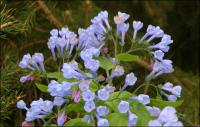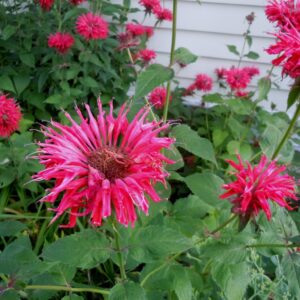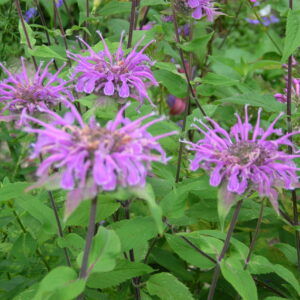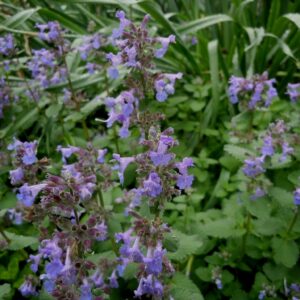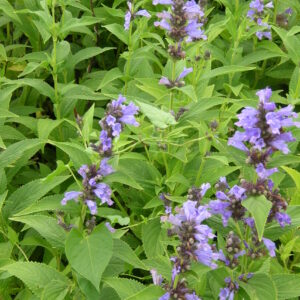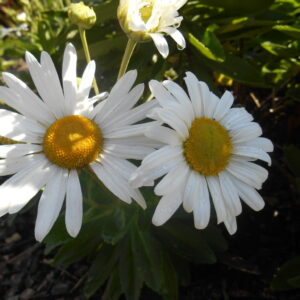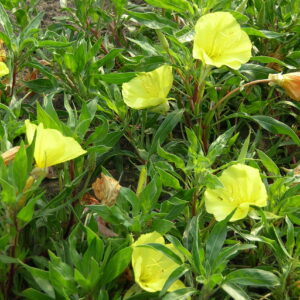Perennials & Biennials
Showing 305–312 of 485 results
-
Matteuccia struthiopteris Ostrich fern Z 3-7
Dissected, feathery fronds resemble ostrich plumes form vase-shaped clumps.
Dissected, feathery fronds resemble ostrich plumes form vase-shaped clumps.
Size: 3-4’ x 5-8’ spreading by rhizomes.
Care: part to full shade in moist well-drained to moist soil
Native: eastern No. America, Wisconsin nativeIn gardens before 1790. Matteuccia is named to honor Italian scientist Carlo Matteucci (1811-1866.) Struthiopteris comes from struthio meaning “ostrich” and pteris meaning “fern.” The fronds are edible – Vermont adopted this as its state vegetable.
-
Mertensia virginica syn. Mertensia pulmonarioides Virginia bluebells Z 3-7
Clusters of pink buds turn to sky blue trumpets in May. Ephemeral, disappearing in summer to return next spring.
Available for purchase in Spring only
Clusters of pink buds turn to sky blue trumpets in May. Ephemeral, disappearing in summer to return next spring.
Size: 18" x 10" spreads slowly
Care: Moist well-drained soil in part shade.
Native: N.Y. to Tennessee, west to Kansas, Wisconsin native
Wildlife Value: Provides nectar and pollen to honeybees, bumble and mason bees, as well as Skipper butterflies and Sphynx moths. Deer resistant.
Awards: Royal Horticultural Society Award of Merit.Cherokee cured whooping cough and consumption with Virginia bluebells. Other Natives treated whooping cough, venereal disease, and plain poor health with this. First collected for gardens by John Banister in colonial Virginia C. 1690. Named Mertensia after Franz Karl Mertens (1764-1831), a German botanist who never set foot in America. Grown by both Washington and Jefferson.
-
Monarda didyma ‘Cambridge Scarlet’ Beebalm Z 4-9
Whorls of scarlet tubes & bracts looking like fireworks, in summer
Whorls of scarlet tubes & bracts looking like fireworks, in summer
Size: 3-4' x spreading
Care: sun to part shade in well-drained soil.
Native: N. E. America
Wildlife Value: Checkered white, Fritillary and Melissa blue butterflies relish Beebalm’s nectar.Cherokee used the species medicinally, to cure colic, flatulence, nosebleed, measles, flu, hysteria and to induce restful sleep. Monarda was named in honor of Nicholas Monardes (1493-1588), a Spanish botanist who wrote about plants of the New World. Discovered by John Bartram (1699-1777) being used by colonists in Oswego N.Y. to make tea. Oswego Indians taught the colonists how to make tea from the dried leaves. Bartram sent this Beebalm to Peter Collinson in England in whose garden it grew in 1744. By 1757 its English availability was “nearly universal” among gardeners. During the American Revolution used as a substitute for tea. Grown at America’s 1st botanic garden, Elgin Botanic Garden 1811.This cultivar ‘Cambridge Scarlet’ recommended by Gertrude Jekyll in 1908.
-
Monarda fistulosa Wild bergamont Z 3-9
Whorls of hooded lavender tubes in July - August
Whorls of hooded lavender tubes in July – August
Size: 3-4' x 2' spreading
Care: Sun to part shade any soil.
Native: central U.S., Wisconsin native
Wildlife Value: Checkered white, Tiger swallowtail, Giant swallowtail and Melissa blue butterflies relish Wild bergamot’s nectar. Supports over 70 bee species including Rusty patched Bumble Bee.Used medicinally by many Native tribes- Blackfoot, Cherokee, Chippewa, Choctaw, Crow, Dakota and Flathead. Cherokee: to cure colic, flatulence, nosebleed, measles, flu, hysteria and to induce restful sleep Blackfoot called it “Single-young-Man.” Teton Dakotas boiled the leaves and flowers for medicine to cure abdominal pain. Ho-Chunk boiled the leaves to make a medicine for pimples. Choctaws cured chest pain in children. The Flathead cured colds and sore teeth with Wild Bergamot. HoChunk inhaled fumes in a sweat bath to cure colds. Oneidas made a tea. For the Sioux it was nourishment and a panacea: tea, stomachache, fever, indigestion, sore throats, fainting, whooping cough, wounds, sore eyes, ulcers, and snakebites. First documented by French explorers before 1635. Plant exported to Europe by Tradescant the Younger in 1637. Grown by Washington at Mount Vernon. Today it is a flavor in Earl Grey tea.
-
Nepeta racemosa syn. N. mussinii Catmint Z 4-8
Lavender blue from May through September, cut back for rebloom
Lavender blue from May through September, cut back for rebloom
Size: 18" x 18"
Care: Full sun in well-drained soil
Native: Caucasus
Wildlife Value: attracts butterflies and bees
Awards: Royal Horticultural Society Award of Merit.Nepetas may have been named after Nepete, an old Etrusrian city. Mussinii named for the plant’s discoverer, Russian Count Apollos Apollosovitch Mussin-Pushkin. In gardens before 1810 and a favorite Victorian bedding plant by the late 1800’s. Catmints contain various amounts of an essential oil (nepetalactone) both a cat stimulant and a mosquito repellant.
-
Nepeta subsessilis Japanese catmint Z 4-8
Showy bluish-purple spikes of bell-shaped flowers forming short spikes, June-September
Showy bluish-purple spikes of bell-shaped flowers forming short spikes, June-September
Size: 18-24” x 18-24”
Care: sun to part shade in moist to moist well-drained soil
Native: Japan
Wildlife Value: deer & rabbit resistant, attracts butterfliesSubsessilis means nearly without stalks. Catmints contain various amounts of an essential oil (nepetalactone) both a cat stimulant and a mosquito repellant. From Nambu Japan where botanists called it Miso-gawa- sô. Von Siebold, German botanist and physician, who worked in Japan from 1823 to1830, saw it. Named in Bull. Acad. Imp. Sci. Saint-Pétersburg, sér. 3, 20: 469. (1875) by Russian botanist Karl Maximowicz.
z.
-
Nipponanthemum nipponicum, syn. Chrysanthemum nipponicum, Chrysanthemum album Nippon daisy, Montauk daisy Z 5-9
Yes, you can have pristine white daisies all summer and into fall. Grow Shastas for summer flowers then pair them with Nippon daisies for 3” blooms in late summer and fall. Excellent cut flower
Yes, you can have pristine white daisies all summer and into fall. Grow your Shastas for summer flowers then pair them with Nippon daisies for 3” blooms in late summer and fall. Excellent cut flower.
Size: 2-3' x 2-3'
Care: sun in well-drained soil. Cut back in early summer to keep it short and bushy, if you wish.
Native: JapanPhysician and botanist Phillip von Siebold (1796-1866) collected it during his 8-year residence in Japan working for the Dutch East India Company. Described in 1872 in Bull. Acad. Imp Sci. Saint Petersburg 17:420 (p. 208) Named Montauk after a ship carrying a shipment shipwrecked at Montauk Long Island and the plants grew on the beach.
-
Oenothera macrocarpa syn. O. missouriensis Ozark sundrops Z 3-7
Big, lemon-yellow blossoms much of the summer, then turn into curious-looking, big oval seed pods
Big, lemon-yellow blossoms much of the summer, then turn into curious-looking, big oval seed pods
Size: 9-12" x 12"
Care: sun in well-drained soil
Native: Missouri & Nebraska
Awards: Royal Horticultural Society Award of Merit.Oenothera is Greek meaning wine tasting referring to the ancient use of Sundrop roots. This discovered in 1810 by Thomas Nuttall when he traveled along the Missouri River “on the elevated summits of the …hills in the vicinity of the lead-mines of the river Meremeck, 30 miles from St. Louis, Louisiana.” (then in the Louisiana Territory). Nuttall described it as a “splendid and singular species.”


